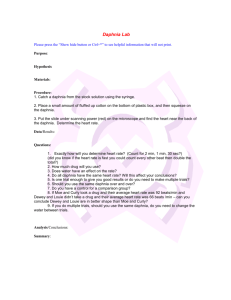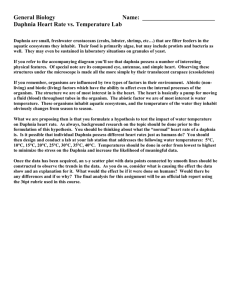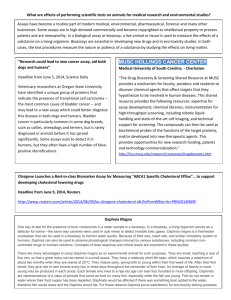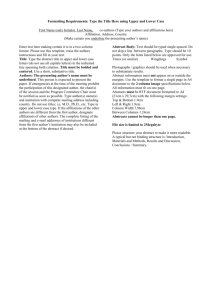CGA5_Scientific Paper Review
advertisement
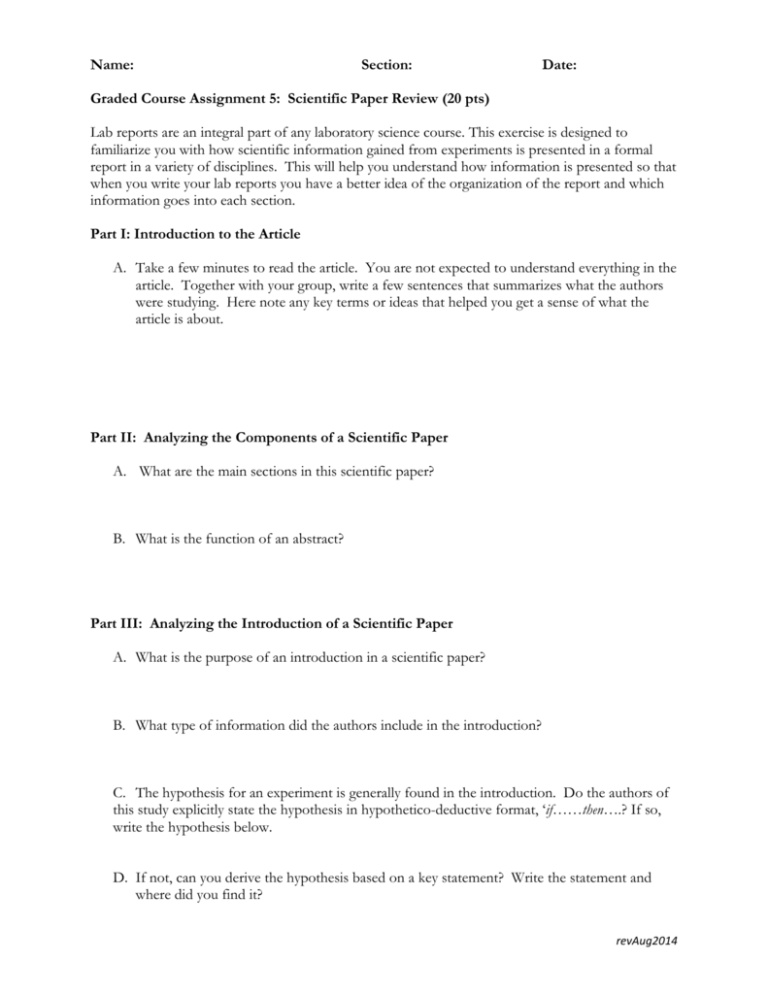
Name: Section: Date: Graded Course Assignment 5: Scientific Paper Review (20 pts) Lab reports are an integral part of any laboratory science course. This exercise is designed to familiarize you with how scientific information gained from experiments is presented in a formal report in a variety of disciplines. This will help you understand how information is presented so that when you write your lab reports you have a better idea of the organization of the report and which information goes into each section. Part I: Introduction to the Article A. Take a few minutes to read the article. You are not expected to understand everything in the article. Together with your group, write a few sentences that summarizes what the authors were studying. Here note any key terms or ideas that helped you get a sense of what the article is about. Part II: Analyzing the Components of a Scientific Paper A. What are the main sections in this scientific paper? B. What is the function of an abstract? Part III: Analyzing the Introduction of a Scientific Paper A. What is the purpose of an introduction in a scientific paper? B. What type of information did the authors include in the introduction? C. The hypothesis for an experiment is generally found in the introduction. Do the authors of this study explicitly state the hypothesis in hypothetico-deductive format, ‘if……then….? If so, write the hypothesis below. D. If not, can you derive the hypothesis based on a key statement? Write the statement and where did you find it? revAug2014 Part IV: A Focus on Procedures/Methods and Materials Section Writing in the Past Tense for the Procedures/Methods and Materials Section In science when we write to explain experiments that were conducted in the past, and therefore have action associated with them, we use the past simple tense. Here is an example of the correct grammar and verb tense when describing part of a procedure for biology. It also shows one way to reference a standard operating procedure. Standard writing and communication practice varies between each discipline and is guided by the journal they are publishing in as well. However, there are some conventions as noted below. Author referenced SOP for mixing artificial lake water. “Daphnia magna were placed in a 30-ml mixture of artificial (combo) lake water (Kilham et al., 1998) and 2.0 x 106 cells/ml of Ankistrodesmus falcatus as a food source for the Daphnia. Another way to reference an author using the above sentence: Based on the standard operating procedure reported by Kilham et al. (1998) Daphnia magna were placed in a 30-ml mixture of artificial (combo) lake water. A cell concentration of 2.0 x 106 cells/ml of Ankistrodesmus falcatus was added as a food source for the Daphnia. Notice that the first sentence had to be broken into two separate sentences to convey the same information. This is fine as long as the information is clear and someone could repeat the experiment. Let’s dissect the first sentence for structure and some common conventions of scientific nomenclature. Shows action in the past tense “Daphnia magna were placed in a 30-ml mixture of artificial (combo) lake water (Kilham et al., 1998) and 2.0 x 106 cells/ml of Ankistrodesmus falcatus as a food source for the Daphnia. Notice that all species are in italics. Notice, that the authors cited the original source that guided them to use the mixture of lake water. They got this information from another published paper or report and therefore needed to reference it. It also represents their standard operating procedure for mixing the artificial lake water. SOP’s for our purposes can be referenced by their SOP reference number. Notice, in one single sentence you know a lot about how Daphnia were maintained. In science we try to be clear, concise, and to the point. revAug2014 A. Find at least 10 examples of action verb tenses in the Materials and Methods section of the paper. Underline or highlight each example. B. How are materials identified in this section? Part V: The Results Section: The Most Important Part of a Report In this section results are summarized. You are not interpreting the data, but rather simply stating what the results are. Findings (results) are summarized using: graphs, tables, and words. The results section presents the results, drawing the reader’s attention to major observations and key trends in the data. DO NOT discuss why the experiment was performed, how it was performed, or whether the results were expected, unexpected, disappointing, or interesting. DO include graphs, tables, calculations, observations and a narrative of the results. Graphs and tables cannot stand alone without being referenced in your narrative. EVERY table and graph is numbered and has a description as part of its presentation. A. Looking at Table Presentation Using the article identify the tables used by the authors. Where is the table description located? What is the function of a table? Is there anything missing from the table? How are the tables organized? B. Looking at Graph Presentation Locate any graphs presented in the article. Where is the graph description located for each? In a scientific report, how are graphs referred to in the paper? What is the independent variable? What axis does it belong? What is the dependent variable? What axis does it belong? Is there a control for this study? What is the significance of a control in a study? revAug2014 C. Looking at Presentation of Statistics What statistics, if any, are reported in this article? (mean, standard deviation, p value, R2 ) What is the statistic used for in this article? Why would a researcher want to report statistics? D. Understanding the Results Section The results are presented not only using figures and tables but also WORDS. How do the figures, tables and words relate to each other? Would you be able to understand the results if one of the three were missing? Why or why not? Part IV: The Discussion: Wrapping it up for the Reader 1. What is the purpose of a discussion in the lab report? 2. In the discussion, what do the authors refer back to when drawing their conclusions? 3. Did the authors discuss limitations, new avenues of research, or propose new hypotheses? Give at least two examples from the article. 4. Why would it be important for the authors to include the information listed in question #3? 5. How many references did the authors use? Where can all cited references be found? revAug2014

